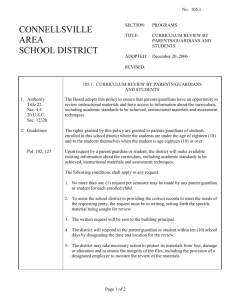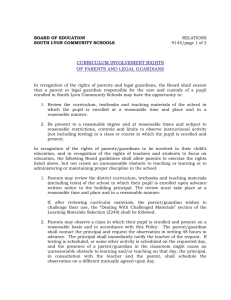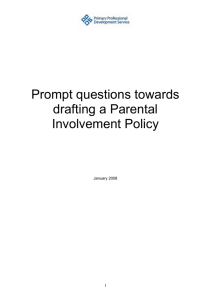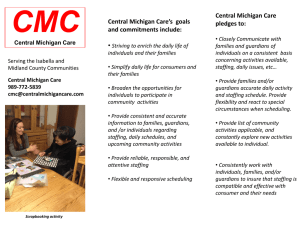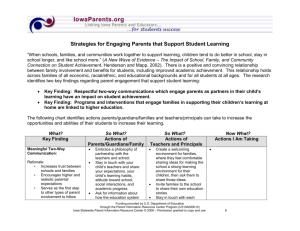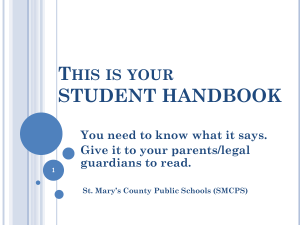Teacher-Parent Communication Styles and Accompanying Difficulties
advertisement
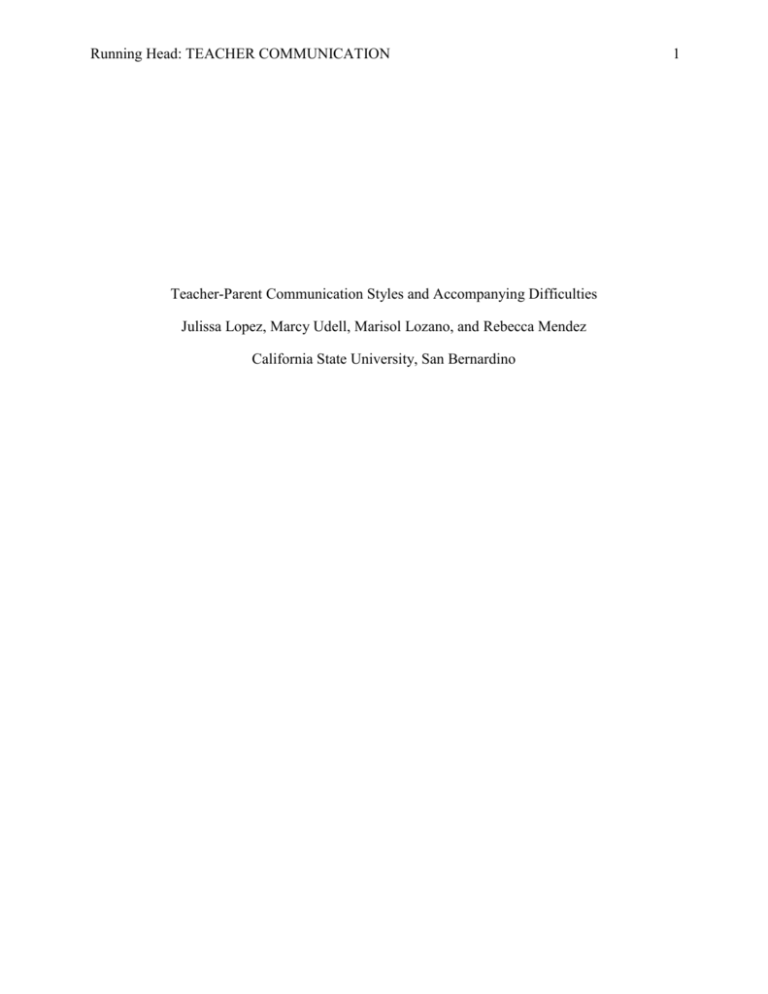
Running Head: TEACHER COMMUNICATION Teacher-Parent Communication Styles and Accompanying Difficulties Julissa Lopez, Marcy Udell, Marisol Lozano, and Rebecca Mendez California State University, San Bernardino 1 2 TEACHER COMMUNICATION Abstract Parents have always occupied a central role in their child’s education. It is important for parents to have a form of communication with teachers to enhance their children’s education. However, it is also important to explore the teacher’s role in the communication process. The objective of this study was to discuss the ways in which teachers communicate with parents, as well as, ways to improve communication. In this study, we used a survey to find current ways in which teachers communicate with parents, the frequency of communication, and improvements that can increase the effectiveness of teacher-parent communication. Many of the articles cited also support our findings. Through our study and articles researched, we found that teachers have a difficult time communicating with parents. Keywords: teacher communication practices, teacher communication difficulties, teacher communication improvements, teacher-parent communication TEACHER COMMUNICATION 3 Teacher-Parent Communication Styles and Accompanying Difficulties General Statement of the Problem The purpose of this study was to research the difficulties between teacher and parent communication. There are many avenues of communication for teachers but many have experienced difficulties in attempting to communicate with parents. There are several factors that contribute to this problem, such as, levels of parental involvement, time constraints, cultural diversity, and teacher training. There were approximately 150 surveys distributed to four different K-12 schools in the Inland Empire. The survey gave teachers the opportunity to list improvements they believe can facilitate communication with parents. Review of Related Literature One of the reasons that teachers may experience communication difficulties with parents is because of their different views on parental involvement. “Teachers tend to have a narrower view of parental involvement as being primarily school- home communication. Parents have a broader view of the kinds of communicative relationships and functions that need to be performed such as attending parenting programs and school activities” (Barge & Loges, 2003). In a study conducted by Barges and Loges, the results showed two common themes emerging from parent, student, and teacher responses regarding what counts as high-quality parental involvement and communication: (a) building positive relationships with teachers and (b) monitoring a child’s academic progress. There were some differences in parent, student, and teacher responses regarding what counts as high-quality parental involvement and communication. First, the idea of discipline and encouragement varies within each group. A second difference among parents, students, and teachers are in regard to the role of extracurricular activities and community support networks in parental involvement. TEACHER COMMUNICATION 4 Similarly, some teachers perceive parents as not being involved in their child’s education, which can also contribute to communication difficulties. In reality, the majority of parents do want to be involved in their child’s education. They are interested in knowing how their child is doing academically and what they can do to help. Misconceptions of a parent’s desire for involvement exist between school and home. Many teachers feel that parents are not willing to become involved in their child’s education and many parents are not aware of opportunities for involvement (Halsey, 2005). Sometimes parents’ busy work schedules interfere with school communication. In addition, some teachers have a limited amount of time during the school day to meet with parents and are not able to meet after work hours. As a result, time constraints interfere with both the quality and quantity of parent-teacher interaction (Cameron & Lee, 1997). Our society has become more culturally diverse, which has had an impact on our school system. Moreover, most of the teachers are Caucasian which can sometimes create a barrier between school and home communication. Teachers may have difficulties communicating effectively with parents from cultures different than their own (Eberly, Joshi, Konzal, & Galen, 2010). Language can be the main communication barrier, but teachers are also unable to relate to the student’s personal experiences. Aside from servicing culturally diverse students, teachers also have the added factor of interacting with students from varying socioeconomic backgrounds. Usually the parents with high socioeconomic status are more educated and involved in their child’s education. According to Raccah and Elyashiv (2008), parents with high socioeconomic status are intensively involved in schools. The more involved parents are, the higher the quality of the teacher-parent communication. On the other hand, the parents with low socioeconomic status are less educated TEACHER COMMUNICATION 5 and usually not as involved in their child’s education. When the parent is not as involved, the teacher may experience communication difficulties. Finally, teacher training is also an added barrier in teacher-parent communication. Teachers are taught how to teach children but they are not trained in how to effectively work with parents. According to Ramirez (1999), “most teachers (70%) felt that in-service strategies could assist teachers in implementing effective parental involvement practices”. Teachers spend a lot of time working with parents and need to be able to communicate effectively with them. For this reason teachers need proper training in communication strategies. Knowing how to effectively communicate with parents will help school and home communication. According to the literature, there are measures that can be taken to decrease the barriers that prevent effective teacher-parent communication. Teachers could do more to involve parents. Parents need to feel like they are a part of their child’s education. Both the teacher and parents need to work together as a team to know what is happening at school and home. Working together will not only help the child, but will prevent any communication difficulties. According to Epstein (1986), “about 58% of the parents rarely or never received requests from the teacher to become involved in learning activities at home. Fewer than 30% of the parents reported that teachers gave them many ideas of how to help their child in reading and math.” Studies have also shown that it is important for teachers and parents to work collaboratively. As teachers and parents work together, the better the communication will be which, in turn, will help the student be more successful. The outcomes of teachers and parents working collaboratively are: higher student achievement, improved student behavior and attendance, and a more positive school climate (Sanders, 2008). TEACHER COMMUNICATION 6 Research Questions After understanding some of the communication difficulties that teachers experience, we wanted to explore what were the existing teacher communication patterns and what were the difficulties in contacting students’ primary guardian(s). Our goal was to investigate the variety of methods in which teachers choose to communicate with primary guardian(s). The study explores the primary issues of why teachers attempt to communicate with a primary guardian. Furthermore, this study examines what obstacles, if any, teachers face when attempting to effectively contact a primary guardian. Lastly, the study explores teacher suggestions in regards to what and how improvements can be made. We anticipate our findings will reveal that teachers use a variety of communication methods. We expect teachers to use means of technology such as phone calls and e-mails. We anticipate teachers also send letters home with their students or through the mail. We believe teachers choose to communicate with parents for a variety of positive and negative reasons. We anticipate teachers come across obstacles when trying to reach a parent. We believe some of the challenges will include language barriers, incorrect contact information or uninterested primary guardian(s). Definition of Terms The following terms are included throughout the study report. The following definitions correlate specifically to the understanding this study. Communication is a process by which information is transmitted and exchanged by means of writing or speech. TEACHER COMMUNICATION 7 Teleparent Call is an automated system which allows school members to send general messages home whenever necessary over the telephone or internet. Primary Guardian is the appointed adult who is responsible for, looks after and has authority over minor student. Significance of the Proposed Study Effective teacher and parent communication is an important foundation which plays a positive role in a student’s academic and social life. Regular communication is a key factor to forming relationships and building a solid support system in working together for the best interest of the student. Unfortunately, effective and regular communication is usually a problematic factor throughout many schools. The significance of this study was to identify and examine which factors contribute to obstacles in communication. The findings from this study will raise awareness and understanding of the exact barriers and will give a clear indication as to what needs to be targeted and improved. The teacher suggestions to improving communication will be useful and provide insight for administrators and district board members. The findings from this study will inform and be a useful tool in developing new strategies and procedures so that policy makers can implement communication improvement within schools. DESIGN AND METHODOLOGY Subjects The subjects in this study were teachers who teach grade levels K-12 in public schools. The educators are employed under four different school districts. The teachers in this study were TEACHER COMMUNICATION 8 all voluntary participants who remain anonymous. The subjects and sites were part of a random sample. The schools consisted of one Elementary, two Junior Highs and one High School; which are all located in southern California within the Inland Empire. Schools were chosen based upon group member affiliations within specific school sites. A total of 126 surveys were completed and submitted. Instrumentation Our qualitative research also included a survey of one hundred and fifty teachers. As a team, discussions were made in the development of the teacher-parent communication questions. We analyzed the survey questions to see if they were cohesive enough to gather information that was needed to understand in greater detail the communication patterns and difficulties. The questions focus on the how and why teachers communicate with parents/guardians. Other questions focus on the success or lack of success in connecting with parents/guardians. All four members of the team assisted in developing the survey, disbursement, and gathering of data. Specifically, the researchers wanted to know what were the communication patterns and difficulties. (See Appendix 1) Data treatment procedures Before the disbursement of the survey, administrators in each school site were approached for participation approval. Some researchers then asked teachers to take a few moments and fill out the survey during staff meetings. Other researchers attached a debriefing note to all surveys that were then put in teacher’s boxes or handed directly to them. Upon completion, teachers returned the surveys to researchers by putting in inbox or handing to researcher. All staff was informed that the data would be kept confidential and what the data was being used for. After the data was collected, the individual researchers tallied the numbers 9 TEACHER COMMUNICATION of the total answers for each question. These numbers were emailed to the other researchers for review. One researcher put all information into Excel to look at trends on communication patterns and difficulties. Results Our research team decided to concentrate on the answers to four questions: 1. What is/are your primary form(s) of communication with parents/guardian? Mark all that apply. 2. What is/are the primary reason(s) for communicating with parents/guardians? Mark all that apply. 3. Have you ever experienced difficulties during your attempts to communicate with parents/guardians? Mark all that apply. 4. What improvements could be made to facilitate communication between parent/guardian and school staff? Please write on the back, if needed. Question One: What is/are your primary form(s) of communication with parents/guardian? Mark all that apply. Home Visit Letter Home Meeting/Parent Conference Email Phone Call Total responses 9 31 35 59 82 216 Given that teachers could mark all that apply, the responses total more than the 126 subjects that participated in the survey. The responses show the Median to be Meeting/Parent Conference with a total of 35 respondents citing this as the primary form of communication with a parent/ guardian (See Figure 1). The Mode for primary form of communication is Phone Calls with 82 respondents frequenting this form of communication. Thus, 82 out of 126 teachers prefer phone calls to communicate with parents and guardians. The Mean shows 1 in every 24 TEACHER COMMUNICATION teacher does a home visit, 1 in every 6 sends a letter home, 1 in every 6 has a meeting/parent conference, 1 in 3 email parents and guardians, and 1 in 2 contacts by phone (See Figure 2). Figure 1. Median for primary form of communication is meeting/ parent conference. Figure 2. Means for primary forms of communication with parent/ guardian. 10 11 TEACHER COMMUNICATION Question Two: What is/are the primary reason(s) for communicating with parents/guardians? Mark all that apply. 1. 2. 3. 4. 5. 6. Other Reminders Student is Doing Well Attendance Concerns Student Struggling Academically Behavior Issues Total responses 4 28 35 36 66 81 250 The responses for this question show the Median is “student is doing well” with 35.5 respondents choosing this as the primary reason to communicate with parents/guardians (See Figure 3). The Mode for this question is Behavior Issues, which was chosen by 81 teachers. The Mean shows 1 out of 62 respondents communicate with parents and guardians for other (unspecified) reasons, 1 out of 8 communicate for reminders, 1 in 7 communicate to let the parent or guardian know that that child is doing well, 1 in 6 communicate with parents and guardians regarding attendance concerns, 1 in 3 contact parents and guardians regarding students struggling academically, and 1 in 3 contact parents and guardians in regards to behavior issues (See Figure 4). Figure 3. Median for primary reason to communicate with parent/guardian is to inform that student is doing well. 12 TEACHER COMMUNICATION Figure 4. Means for primary reasons to communicate with parents/guardians. Third Question: Have you ever experienced difficulties during your attempts to communicate with parents/guardians? Mark all that apply. 1. 2. 3. 4. No Yes, parent is uninterested/uncooperative Yes, language barrier Yes, contact information incorrect Total responses 8 47 58 78 191 The responses for this question show the Median is language barrier with 52.5 respondents citing this as the most experienced difficulty in communicating with parents/guardians (See Figure 5). The Mode for this question show 78 of the teachers do not have the correct contact information. The Mean for the this question shows that 1 in 23 respondents did not have difficulties contacting parents or guardians, 1 in every 4 encountered parents/guardians that were uninterested or uncooperative, 1 in 3 dealt with a language barrier when contacting parents/guardians, and 1 in 2 had incorrect contact information when contacting parents/guardians (See Figure 6). TEACHER COMMUNICATION 13 Figure 5. Median for difficulties experienced when contacting a parent/ guardian is a language barrier. Figure 6. Means for difficulties experienced when contacting parent/guardian. 14 TEACHER COMMUNICATION Question Four: What improvements could be made to facilitate communication between parent/guardian and school staff? Please write on the back, if needed. 1. Home visits 1 2. Anonymous box for parent concerns/comments 1 1 3. Tried everything! Don't Know 4. Attend school meetings 2 5. Parent signature on letters 2 6. Teacher positive comments 3 7. Computer generated communication system 5 8. Teachers need to understand cultural issues 7 9. Administrator involvement 8 11 10. Hold Parents Accountable 11. Active parent role 17 12. More translators 17 13. Parent communication through email 20 14. Update information 35 61 15. No Responses i. Total Surveyed 126 This question asked the participants to write in their suggestions as to what improvements could take place in order to implement the most effective forms of communication with parents or guardians. The Median for this question was 7 respondents answering with “Teachers need to understand cultural issues” (See Figure 7). The Mode for this question was 35 respondents suggesting stronger enforcement of updating student contact information. The Means are as TEACHER COMMUNICATION 15 follows: 1 out of 126 suggested home visits, anonymous box for parent concerns/comments, “tried everything! Don’t know”. One in every 65 suggested parents attend school meetings, and parent signatures on letters. One in every 43 responded that teachers should give more positive comments. One in every 26 said there should be a computer generated communication system. One in every 18 said teachers need to understand cultural issues. One in every 16 felt that administration should be more involved. One in every 11 felt that parents should be held accountable. One in every 7 felt that parents should have a more active role, and believed more translators should be available. One in every 6 felt email communication should be more enforced. Finally, 1 in 3 felt that information should be updated more frequently (See Figure 8). Figure 7. Median for respondent suggestions on how to improve teacher-parent communication. 16 TEACHER COMMUNICATION Figure 8. Means for respondent suggestions on how to improve teacher-parent communication. Discussion This study explored teacher communication styles and some of the difficulties associated with the process of communicating with parents. We began the study by examining some of the factors increasing a teacher’s difficulty in communicating with parents, such as, their perception of parental involvement, time constraints on the teacher and parents’ behalf, the diverse population of students they are servicing, and the need for improved teacher training when dealing with parents. Upon analyzing the results of the survey we conducted in four Inland Empire schools, we found the most frequented form of communication teachers employ to contact parents/ guardians is phone calls. Unfortunately, the primary reason teachers attempt home contacts is to inform parents/ guardians that their child is having behavior issues. Adding to the teacher’s stressor of primarily making calls for behavior issues is that the student contact information is incorrect. Seemingly, the experience for a teacher in communicating with a parent appears to be quite negative. That is why it was important for us to understand what teachers believe would be most conducive in teacher-parent communication process. Overwhelmingly, TEACHER COMMUNICATION 17 most teachers agreed the best way to improve teacher-parent communication is to simply update the student’s contact information. Limitations Some of the limitations in this research include a time constraint, flawed methodology, and the use of a small sample of participants. For many researchers, the research process may take months or years. We only had nine weeks to formulate a research topic, prepare the survey questions, distribute and collect the surveys, and analyze the results. As a result, our time constraint prevented us from examining whether we could have improved upon our methodology. For example, the survey format led to difficulties in calculating the statistical representation of our findings. The survey allowed the participants to respond to most questions with more than one answer. This led to confusion when calculating the mean, median, and mode. Had we been afforded more time to prepare, we could have anticipated the problem that arose when we were trying to analyze our findings. The data was collected from a small sample of administrators and teachers across four different schools in the Inland Empire. The responses of 126 participants may not accurately reflect the experiences of administrators and teachers across California, much less, the United States. For instance, the school staff we surveyed has or is experiencing a language barrier when communicating with parents, which is not surprising considering California is a state with a large Hispanic population. However, for other educators, in states where the Hispanic population is not as large, the language barrier may not be as much of an obstacle. While we did find similarities in the responses across the four different schools we surveyed, we cannot generalize the findings to other schools given our use of convenient sampling. TEACHER COMMUNICATION Recommendation for Future Research For future research, we could expand the study to include parents. This study only focused on the administrator and teacher perspectives of communicating with parents. We recognize it is imperative to study the parent perspective, as well, and what they believe can facilitate their experiences in the school system. Perhaps by learning both perspectives we can implement strategies to diminish communication frustrations with both parties involved. Ultimately, the goal is to help students achieve social and academic success. 18 19 TEACHER COMMUNICATION Appendix California State University, San Bernardino College of Education 1) How long have you been working in the education field? ___________________________________________________________________ 2) What is/are your primary form(s) of communication with parents/guardians? Mark all that apply. Letter home Email Phone call Meeting/ Parent conference Home visit 3) How often do you communicate with parents/guardians? 0 to 5 times a week 6 to 10 times a week 11 to 15 times a week 16 to 20 times a week Other ____________ 4) It is difficult to keep a consistent communication pattern with each student’s parent/guardian. Strongly Disagree Disagree Agree Strongly Agree Other ____________________________________________________________ 5) What is/are the primary reason(s) for communicating with parents/guardians? Mark all that apply. Student is doing well Reminders (events, homework, tests, etc.) Student is struggling academically Behavior issues Attendance concerns Other ____________________________________________________________ 6) Have you ever experienced difficulties during your attempts to communicate with parents/guardians? Mark all that apply. No Yes, language barrier Yes, contact information is incorrect (address is not updated; phone number is disconnected, etc.) Yes, parent is uninterested/ uncooperative 7) What improvements could be made to facilitate communication between parent/guardian and school staff? Please write on the back, if needed 20 TEACHER COMMUNICATION References Addi-Raccah, A., & Arviv-Elyashiv, R. (2008 ). Parent empowerment and teacher professionalism teachers’ perspective. Urban Education, 43(3), 394-415. doi: 10.1177/0042085907305037 Barge, J., & Loges, W. E. (2003). Parent, Student, and Teacher Perceptions of Parental Involvement. Journal Of Applied Communication Research, 31(2), 140-163. doi:10.1080/0090988032000064597 Cameron, C., & Lee, K. (1997). Bridging the Gap between Home and School with Voice-Mail Technology. Journal Of Educational Research, 90(3), 182-90. Eberly, J. , Joshi, A. , Konzal, J. , & Galen, H. (2010). Crossing cultures: Considering ethnotheory in teacher thinking and practices. Multicultural Education, 18(1), 25-32. Epstein, J. L. (1986). Parents' reactions to teacher practices of parental involvement. The elementary school journal, 86(3), 277-294. Halsey, P. A. (2005). Parent Involvement in Junior High Schools: A Failure to Communicate. American Secondary Education, 34(1), 57-69. Ramirez , A. Y. (1999). Survey on teacher's attitudes regarding parents and parental involvement. The school of community journal, 9(2), 21-39. Sanders, M. (2008). How parent liaisons can help bridge the home-school gap. Journal of Educational Research, 101(5), 287-298. TEACHER COMMUNICATION 21
